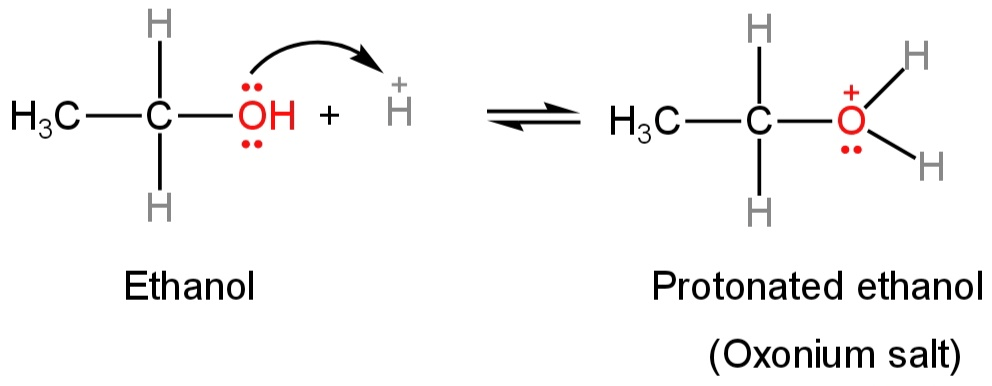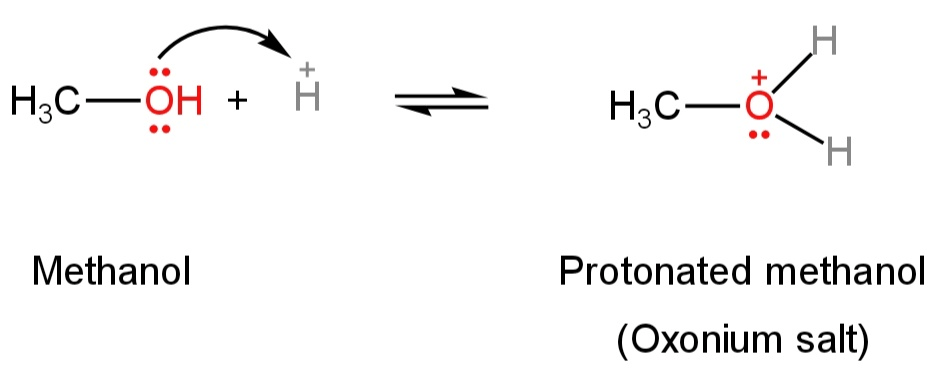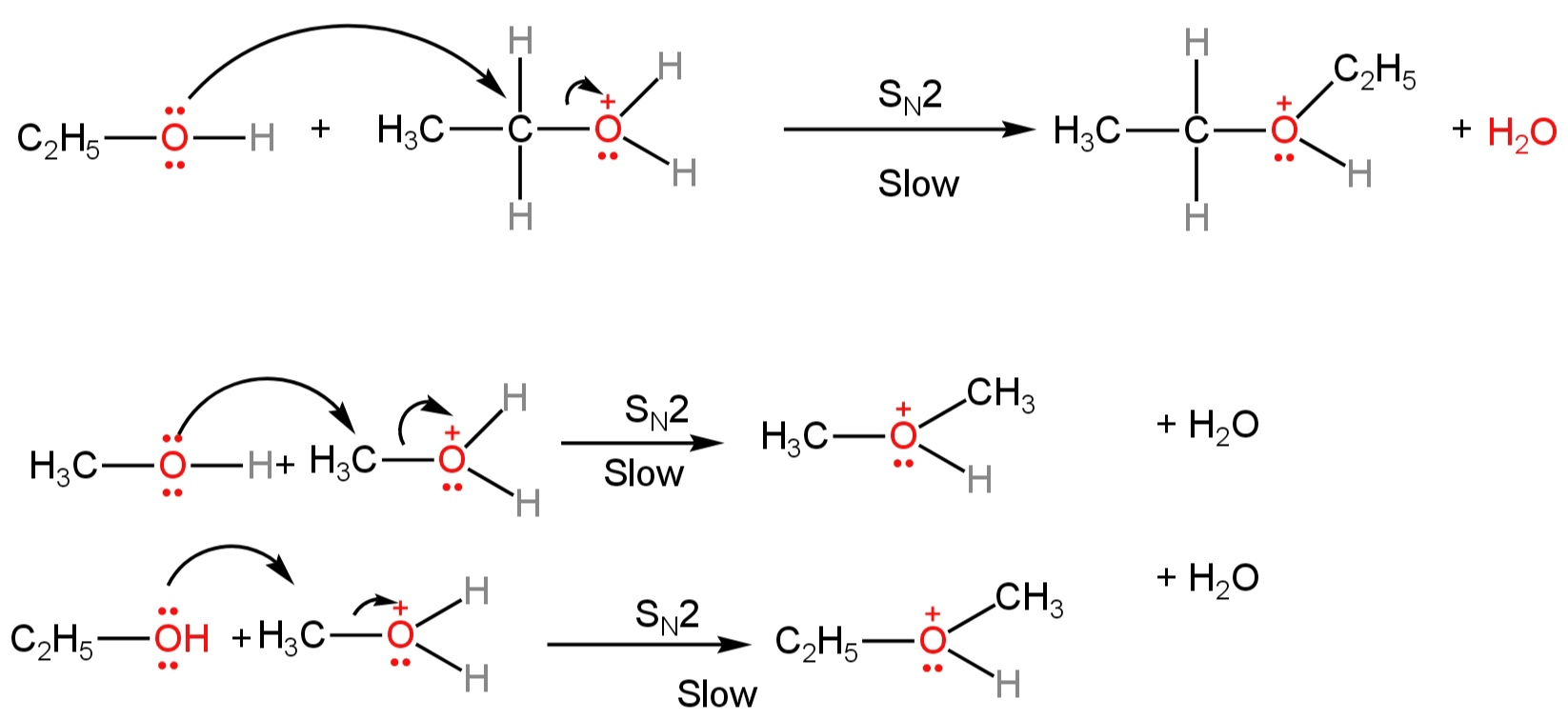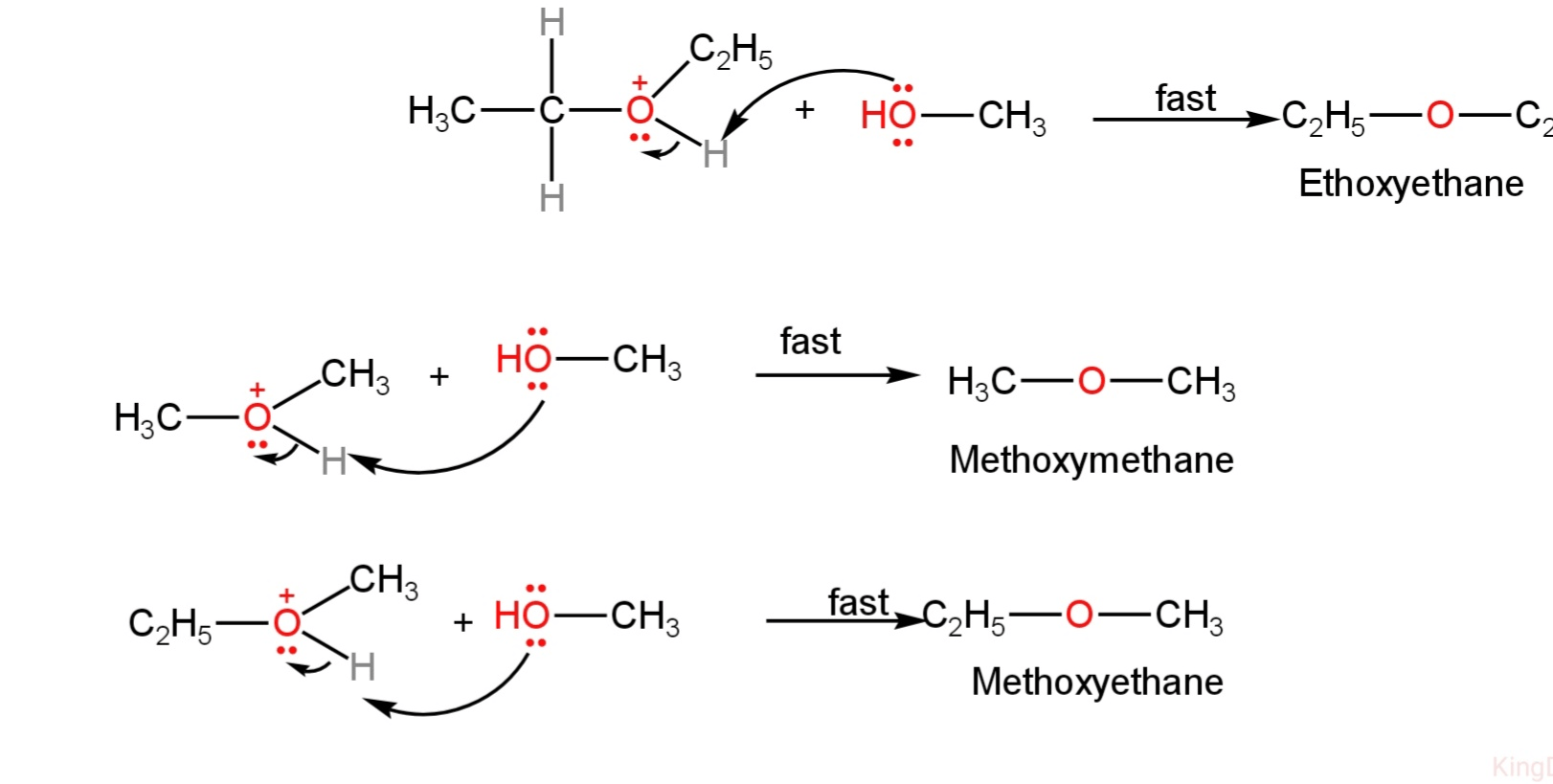
When a mixture of methanol and ethanol is heated in the presence of concentrated sulfuric acid, the resulting organic product or products is/are :
A. CH3OC2H5
B. CH3OCH3, C2H5OC2H5
C. CH3OC2H5, CH3OCH3
D. CH3OC2H5, CH3OCH3, and C2H5OC2H5.
Answer
359.7k+ views
Hint: Alcohols undergo dehydration in the presence of protonic acids to give alkenes or ethers. The product formation depends on the reaction conditions. Protonic acids involve concentrated sulfuric acids or phosphoric acid.
Complete Step by Step Answer:
Symmetrical ethers may be formed by the dehydration of alcohols either in the presence of acids or heated alumina.
Dehydration means the loss of water.
Methanol and ethanol will undergo dehydration if heated in the presence of concentrated sulfuric acid at 413 K.
For example, if excess ethanol is taken at 413 K, ethoxyethane is the main product.
This reaction is the acid-catalysed dehydration of alcohol.
This is a bimolecular substitution reaction involving the attack of the alcohol molecule on a protonated alcohol molecule.
This reaction occurs in three steps:
1. Protonation of alcohol
The presence of two lone pairs of electrons on the oxygen atom of alcohol makes it a Lewis base.
So, they react with strong mineral acids like sulfuric acid to form oxonium salts.
Ethanol forms protonated ethanol and methanol forms protonated methanol.


Image: Formation of protonated alcohol
2. Due to the presence of a positive charge on the oxygen atom, the carbon next to the oxygen atom becomes electron deficient.
So, nucleophilic attack by the deprotonated alcohol molecule occurs on the protonated alcohol to form protonated ether molecules with the loss of water.

Image: Formation of protonated ether.
3. The alcohol molecule finally abstracts a proton from the protonated ether to form ethoxyethane, methoxymethane and methoxyethane.

Image: Formation of ether
So, ethoxyethane, methoxymethane and methoxyethane are formed when a mixture of methanol and ethanol is heated in the presence of concentrated sulfuric acid.
So, option D is correct.
Note: At 413 K, formation of ethers from primary alcohols is accompanied by formation of small amounts of alkenes. Therefore, it is the suitable way of preparation of ethers having unhindered primary alkyl groups. For secondary and tertiary alcohols due to presence of bulky alkyl groups, nucleophilic attack of lone pair of oxygen is not possible due to steric hindrance. So, alkenes are formed in large amounts.
Complete Step by Step Answer:
Symmetrical ethers may be formed by the dehydration of alcohols either in the presence of acids or heated alumina.
Dehydration means the loss of water.
Methanol and ethanol will undergo dehydration if heated in the presence of concentrated sulfuric acid at 413 K.
For example, if excess ethanol is taken at 413 K, ethoxyethane is the main product.
This reaction is the acid-catalysed dehydration of alcohol.
This is a bimolecular substitution reaction involving the attack of the alcohol molecule on a protonated alcohol molecule.
This reaction occurs in three steps:
1. Protonation of alcohol
The presence of two lone pairs of electrons on the oxygen atom of alcohol makes it a Lewis base.
So, they react with strong mineral acids like sulfuric acid to form oxonium salts.
Ethanol forms protonated ethanol and methanol forms protonated methanol.


Image: Formation of protonated alcohol
2. Due to the presence of a positive charge on the oxygen atom, the carbon next to the oxygen atom becomes electron deficient.
So, nucleophilic attack by the deprotonated alcohol molecule occurs on the protonated alcohol to form protonated ether molecules with the loss of water.

Image: Formation of protonated ether.
3. The alcohol molecule finally abstracts a proton from the protonated ether to form ethoxyethane, methoxymethane and methoxyethane.

Image: Formation of ether
So, ethoxyethane, methoxymethane and methoxyethane are formed when a mixture of methanol and ethanol is heated in the presence of concentrated sulfuric acid.
So, option D is correct.
Note: At 413 K, formation of ethers from primary alcohols is accompanied by formation of small amounts of alkenes. Therefore, it is the suitable way of preparation of ethers having unhindered primary alkyl groups. For secondary and tertiary alcohols due to presence of bulky alkyl groups, nucleophilic attack of lone pair of oxygen is not possible due to steric hindrance. So, alkenes are formed in large amounts.
Recently Updated Pages
Questions & Answers - Ask your doubts

A man running at a speed 5 ms is viewed in the side class 12 physics CBSE

State and explain Hardy Weinbergs Principle class 12 biology CBSE

Which of the following statements is wrong a Amnion class 12 biology CBSE

Two Planoconcave lenses 1 and 2 of glass of refractive class 12 physics CBSE

The compound 2 methyl 2 butene on reaction with NaIO4 class 12 chemistry CBSE

Trending doubts
What is BLO What is the full form of BLO class 8 social science CBSE

Differentiate between an exothermic and an endothermic class 11 chemistry CBSE

Which places in India experience sunrise first and class 9 social science CBSE

The shortest day of the year in India

What are the major means of transport Explain each class 12 social science CBSE

Which are the Top 10 Largest Countries of the World?




